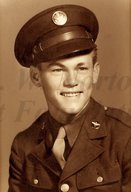
|

|
|
|
|
Born in Santa Maria, California, Raymond was working a lathe as he finished Whittier Union High School in Whittier, California. He had climbed to a foreman position at Nemec Combustion Engineers, which made aircraft parts, when the war began. Raymond enlisted in the Army Air Forces in March of 1942 to become an aircraft mechanic. Later, however, he went into flight school. Trained as a B-26 pilot, he left Barksdale Field in June of 1944 for Tunis, where he joined the 319th Bombardment Group. All B-26 aircraft were sent to France, he says, so he was changed to a B-25. "My first ride in a B-25 was combat," he comments. Stationed on Corsica, Raymond flew out of a base he describes as "just a clearing in the trees." On missions, he hit bridges and marshaling yards in southern France and the Po Valley in northern Italy in trying to prevent the enemy from moving farther south down the boot. Raymond flew seventeen missions, most about five to six hours in length. Back at the base, they ate C-rations and shaved out of helmets. "When you weren't flying you were either trying to clean something up or writing letters," he recalls. He was still on Corsica on VE Day. The 319th traveled to Naples where they boarded the SS United States in late December of early 1945, and sailed to Boston. "We got real milk and we all got a steak," he says of his homecoming. After a thirty-day leave, Raymond was sent to the Pacific Theater where he flew "eight or nine" missions from Okinawa. He recalls seeing the cloud above Hiroshima from the atomic blast, but did not know what it was at the time. "There was a lot of whooping and hollering going on," he says of their learned about the atomic bomb. "We showed them we did have a big stick." Raymond came home as a second lieutenant, and worked for Wray Ford in Shreveport. He joined the reserves and was flying B-29s when he was called up during the Korean War. Raymond remained on active duty, flew B-52s, and retired in 1974. He later worked in commercial heating and air conditioning. |


